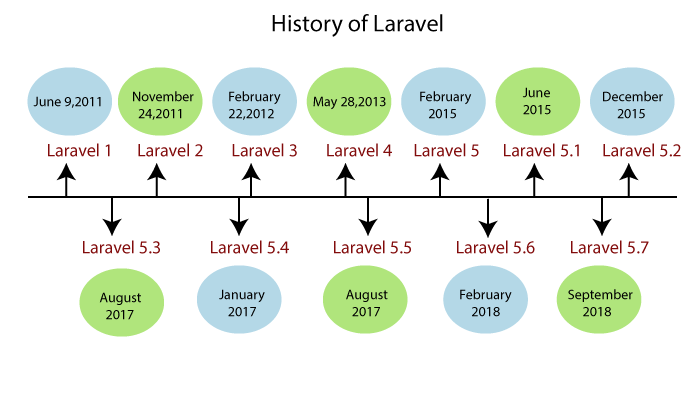History of LaravelIn 2011, Codeigniter was the most popular framework used in php. It was widely used as it was easy to learn and well documented. Web developers created many projects by using the CodeIgniter framework, but it lacked certain essential features such as user authorization and authentication. Taylor Otwell started the development of Laravel to provide an alternative of the Codeigniter framework. Versions of Laravel
Laravel 1Laravel's first beta version was released on June 9, 2011, and after the release of a beta version, Laravel 1 was released within one month. Laravel 1 has some in-built features such as authentication, eloquent ORM for database operations, localization, models and relationships, simple routing mechanism, caching, sessions, views, extendibility through modules and libraries, and HTML helpers. Laravel 1 does not follow the MVC framework, but developers use this framework as its syntax is very clear. After the development of Laravel 1, Taylor Otwell added new features such as validation methods, pagination, a command-line package installer, and eloquent ORM. Due to the addition of the new features, a new version was developed, i.e., Laravel 2, and this version was developed in less than six months. Laravel 2Laravel 2 version was released on November 24, 2011. Laravel 2 removes the issues that are raised in Laravel 1, and Laravel 2 follows the MVC architecture. Laravel 2 can be considered as a true MVC framework. In September 2011, Laravel 2 released in-built support for controllers, templating engine called blade, inversion of control principle (IOC). Due to the addition of controllers, Laravel 2 framework becomes a fully qualified MVC framework. The major drawback of this framework is that it eliminates the support for third-party modules. Laravel 3Laravel 3 version was released on February 22, 2012. The release of this version includes some essential features such as unit test integration, Artisan command-line interface, database migrations, events, sessions drivers, database drivers, and many more. Laravel 3 was the most stable and simple framework used in various kinds of web applications. Laravel 3 came into the market as the stable release, and many developers started switching to the Laravel framework. After five months release of Laravel 3, creator of the framework started working to create a new version of the framework, i.e., Laravel 4. Laravel 4Laravel version was released on May 28, 2013, i.e., a year and 3 months after the release of version 3. Even though releasing new versions is the sign that the framework is evolving, but it is lowering the credibility of the framework. The developers asked for stability, so Laravel 4 came into the market to achieve a bright future in the PHP development. Laravel 4 was written from scratch as a collection of components which are integrated with each other. The management of these components is done through the dependency manager known as Composer. Laravel 4 has an extended set of features that no other version of Laravel had to offer before such as database seeding, message queues, built-in mailer, eloquent ORM featuring scopes, soft deletes, and many more. Laravel 5Laravel 5 version was released on February 2015 as an enhancement of previous version Laravel 4. The new features added in Laravel 5 are scheduling executed tasks periodically through a package is known as Scheduler, an abstraction layer known as Flysystem which allows remote storage to be used in the same way as the local file system, Elixir, simplified the authentication through the use of Socialite package. It also introduced a new feature, i.e., directory tree structure for developed applications. Laravel 5.1Laravel 5.1 was released in June 2015. It includes new features such as new directory structure, simplified method injection, and the concept of route caching was introduced. Laravel 5.2Laravel 5.2 was released on December 2015, and the features added in this version are authentication scaffolding, array validation, server monitoring, and Laravel cashier. Laravel 5.3Laravel 5.3 was released in August 2016. It includes features such as Laravel echo, new notification system, Laravel Scout, and passport. Laravel 5.4Laravel 5.4 was released in January 2017. It includes features such as Laravel Dusk, Laravel Mix, Automatic Facades, and provides improvements in Routing. Laravel 5.5The Laravel 5.5 version was released in August 2017. The introduction of PHP 7 was introduced in this version to enhance the performance of the Laravel application. It also includes new features such as Route methods and Automatic Package Discovery to add the packages automatically. Laravel 5.6The Laravel 5.6 version was released in February 2018. It includes new features such as new blade directives and API controller generation. The new features like Argon and Password Hashing Support are also added in this version. The Bootstrap 4 was released before the release of Laravel 5.6, so Bootstrap 4 was introduced in this version. Laravel 5.7The Laravel 5.7 version was released on September 2018 that includes features such as Laravel Dump Server and Laravel Nova. Some additional features are also added in this version like URL Generator and Callable Syntax, and improved error messages.
Next TopicXAMPP Installation
|
 For Videos Join Our Youtube Channel: Join Now
For Videos Join Our Youtube Channel: Join Now
Feedback
- Send your Feedback to [email protected]
Help Others, Please Share









